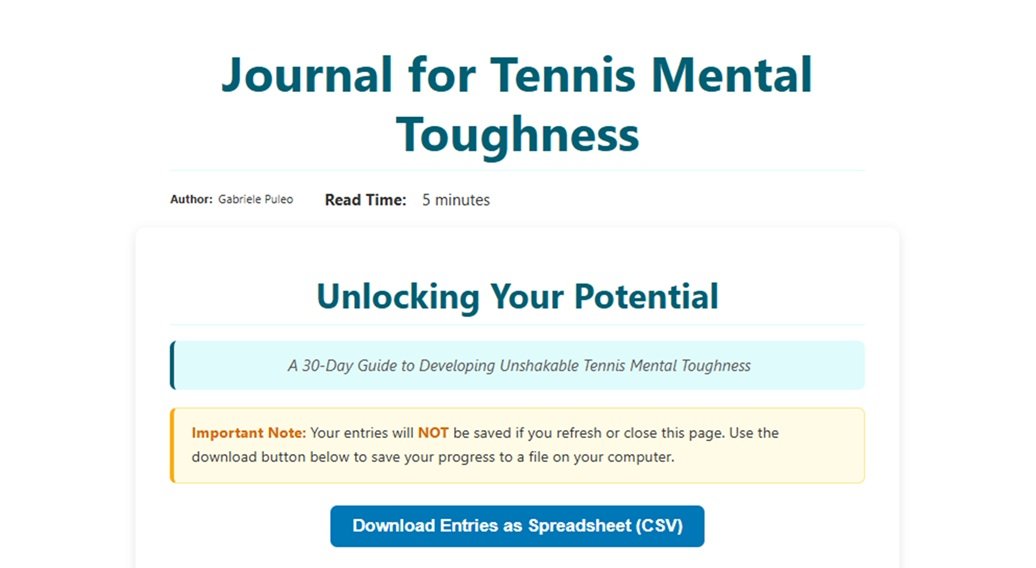I will try to show you how to forge this tennis mental toughness in just 30 days. It won’t be easy, but if you’re tired of losing matches you know you should have won, this journey is for you.
Imaging you’re at a break point. Sweat is dripping down your forehead, your heart is pounding, and your grip on the racket feels slippery.
You have practiced this shot thousands of times, and you own it in drills. But now, with the match on the line, your arm feels like a wet noodle, and you dump the ball right into the net.
It’s an infuriating feeling, isn’t it?
If you’ve ever cracked a racquet or had stern talks with yourself after a tough loss, you’re not alone.
After years of competing and obsessing over this sport, I discovered a crucial truth. The biggest opponent any tennis player faces isn’t on the other side of the court; it’s the one between their ears.
Developing an unshakable tennis mindset isn’t magic reserved for the professional tennis circuit. It’s a skill, a form of mental training, that you can build.
Week 1: Laying the Foundation with Honest Awareness
Before you can build mental strength, you need a solid foundation.
This first week isn’t about winning more points; it’s about a raw, unfiltered self-assessment to understand why you’re losing them.
I made a journal for you to start using. Give it a try.
Days 1-3: Become a Mental Detective
For the first three days, your most crucial tool will be a tennis journal (I made one for your here.
This might seem like a homework assignment, but this exercise is vital. After every practice or match, don’t just note your technical errors; write down how you felt.
- When did you feel nerve kick in?
- What specific thoughts went through your head before an unforced error?
- How did your body react to pressure? (e.g., tight shoulders, shallow breathing)
Be brutally honest. Did you think, “don’t miss this” right before a double fault? Write it down. This journal is your first step to spotting the negative thought patterns that are sabotaging your on-court performance.
Days 4-7: Accept Your Setbacks Without Judgment
With data from your journal, it’s time for acceptance. Realizing you choke under pressure doesn’t feel good, and the natural reaction is to judge yourself with thoughts like, “I’m a head case.”
Your goal this week is to stop that negative self-talk and simply observe and accept.
Instead of, “I’m a disaster under pressure,” try an objective observation: “I notice that my heart rate increases and my thoughts turn negative on big points.”
This shift in perspective is key. Accepting your current tendencies doesn’t mean you’re resigning yourself to them; it means you’re acknowledging your starting point.
You can’t fix a leak if you first don’t admit there’s a hole. Many an athlete will try to skip this crucial step in their mental training.
Week 2: Mental Training to Rewire Your Brain
Now that you’ve identified the mental challenges, it’s time to fight back.
This week, we will use two powerful tools from sport psychology: visualization and controlled self-talk, to enhance your mental game.
Days 8-11: Direct Your Own Mental Highlight Reel
Visualization is a deliberate mental rehearsal, not just daydreaming. Every night, spend 10 minutes visualizing yourself playing incredible tennis with strong focus.
Get specific with this exercise:
- Feel the perfect contact of the ball on your racquet’s sweet spot.
- Hear the “pop” of a flat, unreturnable serve.
- Watch the ball land exactly where you intend.
- Visualize yourself walking with confidence between points, even after an error.
This technique can overcome specific issues, like yips on a second serve, in high-stakes moments. By visualizing the perfect motion over and over, your brain has already “hit” a successful serve hundreds of times before you have to do it under pressure.
This preparation builds an unshakable belief in your ability.
Days 12-14: Master Your Internal Script
On the tennis court, your inner narrator can be your greatest cheerleader or your worst critic.
In Week 1, you identified the negative scripts; now it’s time to rewrite them. When you catch yourself thinking, “Don’t shank this forehand,” you must actively replace it with a positive, action-oriented instruction.
- Instead of: “Don’t hit it into the net.”
- Think: “Drive the ball three feet over the net.”
- Instead of: “Don’t double fault.”
- Think: “Good toss and follow through.”
This change requires conscious effort and is a core part of mental toughness training.
You are teaching your brain a new language of confidence, not fear, by creating new neural pathways. This mental approach is what separates a good athlete from a champion.
Week 3: Forging Resilience and Pressure Management in Tennis Mental Toughness
You’ve laid the groundwork; now it’s time to stress-test your new mental skills.
Resilience is the ability to bounce back from errors and is the heart of an unshakable tennis mindset.
This is how you learn to play like a pro when facing tough opponents.
Days 15-18: The 16-Second Cure: Your Reset Routine
Pro players like Nadal have a meticulous pre-point routine for a reason. It’s a reset mechanism that helps them leave the last point behind and focus entirely on the next.
You need to create your own simple, four-phase routine to use between every point.
- Response Phase (3-4 seconds): Allow a brief, physical reaction. A quick fist pump for a win or a light thigh tap for a loss.
- Relaxation Phase: Turn your back to the net and walk to the fence, focusing on your breathing. This relaxation technique helps you maintain composure and grounds you in the present.
- Preparation Phase: As you walk back to the baseline, decide on your strategy for the next point. Where will you serve? What pattern will you play?
- Ritual Phase: Before you serve or return, perform a final ritual, like bouncing the ball three times. This is the final switch that signals you are ready.
Practice this routine relentlessly in your drills until it becomes automatic. When you’re under pressure, this routine will be your autopilot.
Days 19-21: Learn to Love the Battle
Pressure is a privilege; it means you’re in a situation that matters.
You must transform your perspective and see these tense moments as the reason you play the sport. When the score is 5-5 in the third set, tell yourself, “This is what I train for. I love this stuff.”
Saying this can shift your physiological state and harness your adrenaline positively.
To enhance this skill, create pressure games in practice. Play sets where every game starts at 30-30, or play tiebreakers where the loser picks up the balls.
This kind of practice helps you get used to performing with that feeling of adrenaline.
Week 4: Achieving Autopilot through Routine and Laser Focus
The final week is about making your mental toughness a habit. The objective is for your newfound mental resilience to become second nature, allowing you to achieve a breakthrough in your overall performance.
Days 22-25: Master Your States of Focus
Focus in tennis is a series of intense, short bursts of concentration, not a constant state. Mastering your focus means knowing what to focus on and when.
- Between Points: Your focus should be broad. Use your 16-second routine, look around, and breathe.
- Right Before the Point: Narrow your focus to a simple strategy, like “serve to the T.”
- During the Point: Your focus should be extremely narrow and external: Just watch the ball. Forget the score or your opponent; your entire universe should shrink to that fuzzy yellow ball.
Trust your training and let your body execute. Practice shifting these states of focus during drills, just like any other part of your tennis game.
Days 26-30: Trust the Process for Unconscious Confidence
In these final days, consolidate everything. Continue with your journal, visualization, reset routine, and self-talk, but with less conscious effort.
The ultimate goal of this mental training is to cultivate unconscious confidence.
This type of confidence doesn’t come from slogans; it comes from knowing you’ve done the work and have a plan for when things get tough. It comes from knowing you can overcome setbacks because you’ve done it before.
At the end of these 30 days, you won’t be invincible. You will still make errors, but the difference is that you won’t fall apart.
You’ll have the tools to handle adversity, seeing a break point not as a threat, but as an opportunity to excel.
Conclusion: Your Mental Journey Is Just Beginning
This 30-day plan is your starting point for building a tennis mindset that won’t crack under pressure.
We’ve covered a holistic approach, from becoming a detective of your own meltdowns to rewriting internal scripts and sharpening your focus like a pro.
This is not a magic bullet, but a continuous practice.
You now have a roadmap and a set of mental tools that most players ignore while blaming their equipment.
The next time you’re stepping onto the court and feel that pang of panic on a big point, smile. You’ll know exactly what to do: walk to the fence, take a breath, focus on the ball, and trust your work.
Now go out there and elevate your game to new heights.



